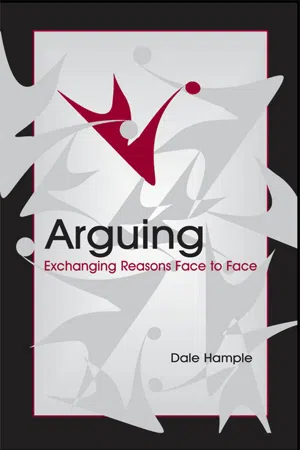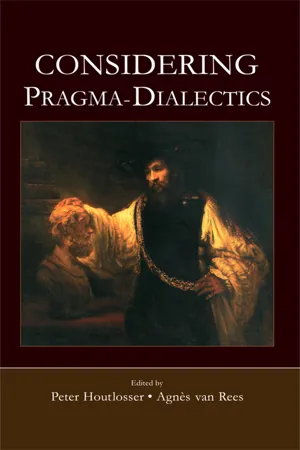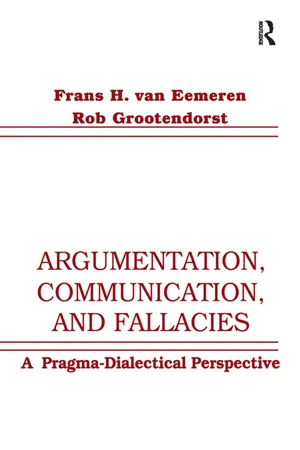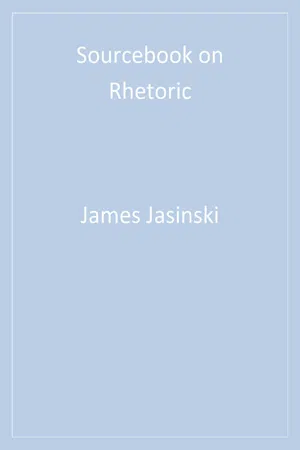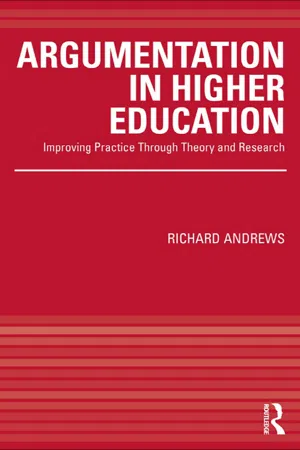Languages & Linguistics
Argumentation
Argumentation refers to the process of presenting and defending a position or viewpoint through logical reasoning and evidence. In the context of languages and linguistics, argumentation involves analyzing and constructing persuasive arguments related to language use, structure, and meaning. It encompasses the study of rhetoric, persuasion, and the effective communication of ideas within the field of linguistics.
Written by Perlego with AI-assistance
Related key terms
7 Key excerpts on "Argumentation"
- eBook - ePub
Arguing
Exchanging Reasons Face to Face
- Dale Hample(Author)
- 2006(Publication Date)
- Routledge(Publisher)
Chapter 1: Definition of Argument An argument is a conclusion supported by a reason. Normally, the conclusion is something that is controversial (or at least not obvious) before the argument is absorbed. Consequently, some element of the reason—the part normally called the evidence or the data—should be immediately acceptable. That way, the argument moves from the known to the unknown, or from the taken-for-granted to the doubtful. Arguing is something that can only be done by people. Paragraphs do not argue, and neither do propositions. Arguing is a fundamental human activity, perhaps the primary means of coming to new understandings. Argumentation began its academic life as a part of rhetoric and did not really take on any distinct academic identity until the final decades of the 20th century. Consequently, its heritage and definitions derive from several ancient traditions. One of these is rhetoric, of course, but its contributions are intertwined with those of the other disciplines. Dialectic is an important contributory literature. For Aristotle, rhetoric was an offshoot of dialectic (Rhetoric, 1354a). This remark has been the subject of much discussion. Dialectic is a mode of philosophical inquiry, in which (prototypically) two people try to work out the solution to a deep problem—for instance, what is the nature of justice? Although each dialectician may begin with a point of view, once a position is expressed, neither person advocates. Instead, each interlocutor takes the standpoint as something to be tested argumentatively. Definitions are exposed and tested, evidence is sought, and all reasoning is explicit and available for criticism. Nothing personal is supposed to be involved, so the parties’ status, reputations, prior commitments, and other attributes are set aside. Knowledge is shared, rather than being husbanded as a rhetorical resource - eBook - ePub
- Peter Houtlosser, Agnes van Rees(Authors)
- 2014(Publication Date)
- Routledge(Publisher)
The term Noosphere means the “the sphere of reason.” It was suggested by Pierre Teilard de Chardin and Eduourd le Roy and later taken and developed by Vladimir Vernadsky. According to Vernadsky, the Noosphere is a new evolutionary condition of uniting humanity under the auspice of science. Despite the idealistic original interpretation of the concept, modern global upheavals give impetus to a closer study of this concept. It gives the idea of an integrated conception of development, and a reasonable attitude to social discourse. The analytical (dealing with reason) and pragmatic (dealing with the social aspect) constituents have become the core of modern research paradigms that can be regarded as open systems. These new paradigms are based on the principle of complex dynamic and open systems of a nonlinear type where time and space come as one integral part. With the development of cognitive studies there exists a strong tendency of matching natural and artificial intelligence studies which, together with the studies of self-organized systems, enrich discourse studies. The paradigm of sustainable development is connected with open functional systems, which are presently connected with discourse analysis and discourse linguistics as its types.Rhetoric and Argumentation theory are now incorporated into linguistic research because they can provide the interpretation of social behavior that influences mentality. The interpretational aspect introduced a cognitive-discourse paradigm that deals with open systems and involves interpretation as a procedural work while the interpreter tries to combine diverse objectives and viewpoints. It is through the theory of Argumentation that one can obviously achieve this goal, as the structure of argumentative discourse is closely connected with the changes in social environment.The concept of discourse is used in many disciplines and approaches in linguistics and philosophy. Discourse theory deals with the analysis of speeches, writings, interviews, and conversations. Much attention was drawn to such aspects as opening and closings, the introduction of topics, and turntaking, and the analytical focus is restricted to small segments of speech and writing. Under the influence of the works of Michael Foucault a critical discourse analysis was developed. Discursive structures were looked upon as references to regular bodies of ideas and concepts which claim to produce knowledge about the world. Language users, according to this approach, are defined as “members of communities, groups, organizations and are supposed to speak, write and understand from a specific social position. Ideological analysis then examines what ideologies are typically associated with this or that position” (van Dijk, 1995, p. 136).The core characteristic of discourse lies in the possibility of interpretation and reconstruction of the mental activity and advancing reconstruction and interpretation of arguments (van Eemeren, Grootendorst, Jackson & Jacobs, 1993; van Rees, 2001). The topic of the discourse is disclosed by the analyst through propositions which are construed into patterns, and further analysis might point out linguistic devices, logical or referential relations. - eBook - ePub
- Michael A. Gilbert(Author)
- 2013(Publication Date)
- Routledge(Publisher)
Wenzel offered several further distinctions when, in 1980, he allowed for three separate perspectives on argument. The first, the traditional category of argument as object, e.g., a syllogism, he termed ‘product.’ The second, ‘procedure,’ encompassed the rhetorical skills and insights accumulated over the ages. From the point of view of procedure, argument is something that can be analyzed for its persuasive impact and its use of rhetorical technique. ‘Process’ was the term that described what is often called ‘dialectic’: two individuals using critical rationality to investigate or determine the truth. Many of the problems plaguing Argumentation Theory, he claimed, were a result of attempting to find one all encompassing approach for three distinct endeavors.What was most significant about these writings was their integration of logical and Argumentation concepts that went beyond the traditional categories in Communication Theory. They witnessed an awareness of a growth toward the investigation of dialogic Argumentation while at the same time holding onto the basal concepts of rhetorical and speech studies. It was, after all, not only philosophy that had concentrated on the static argument, but rhetoric as well. Concern with the analysis of public speeches was to be replaced by a focus on the interaction undertaken by people in disagreement. This required new concepts and distinctions, such as argumenti and argument2, that would permit the scholar to differentiate between different concerns.One major influence on Argumentation Theory and, indeed, Communication Theory in general has been the Social Constructvitist approach. Willard, in a 1978 article entitled, “A Reformulation of the Concept of Argument: The Construc- tivist/Interactionist Foundations of a Sociology of Argument,” utilizes Personal Construct Theory and Chicago School Interactionism to define argument “as a specific kind of social relationship or encounter” (p.121). More particularly, “argument is a kind of interaction in which people maintain what they construe to be mutually exclusive propositions” (p.125, emph. orig.). This approach, popular in Communication Theory, meant that Argumentation Theory had a descriptive role as well as its traditionally normative function. In order to understand argument, we must begin with arguers. - eBook - ePub
Argumentation, Communication, and Fallacies
A Pragma-dialectical Perspective
- Frans H. van Eemeren, Rob Grootendorst(Authors)
- 2016(Publication Date)
- Routledge(Publisher)
For that purpose, Argumentation is first put in a communicative perspective (Part I), then the fallacies are discussed that occur when certain rules of communication are violated (Part II). In so doing, a pragma-dialectic alternative is offered to both a linguistically inspired descriptive and a logically inspired normative approach to Argumentation. Part I of the book, “Argumentation and Communication,” provides a theoretical framework for dealing with argumentative discourse. We discuss the speech acts that play a part in a critical discussion aimed at resolving a difference of opinion. The various stages of a critical discussion are distinguished and the communicative and interactional aspects are considered of the speech acts that are performed in resolving simple or more complex disputes. Argumentation is characterized as a complex speech act in the Argumentation stage. In order to make up for the seemingly unworldly ideal of critical discussion, special attention is paid to various real-life complications in dealing with argumentative discourse. Some guidelines are formulated for analyzing indirect speech acts and unexpressed premises and the structural differences are discussed between single, multiple, co-ordinatively compound, and subordinatively compound Argumentation. After having dealt with these crucial aspects of analysis, Part II, “Communication and Fallacies,” links the evaluation of argumentative discourse to its analysis and concentrates on the obstacles to achieving a resolution of a dispute. Making use of the theoretical framework outlined in Part I, we present 10 basic rules for critical discussion - eBook - ePub
- James L. Jasinski(Author)
- 2001(Publication Date)
- SAGE Publications, Inc(Publisher)
Although the project of explicating the various forms and strategies of argument is critical to argument theory, it does not exhaust the study of Argumentation. The realm of argument scholarship and the interests of argument scholars extends beyond the development of argument typologies. The remainder of this entry sketches some key areas in contemporary Argumentation theory. 35 There are a number of relatively distinct programs or traditions in contemporary Argumentation scholarship. Some of the more important ones include the Dutch pragma-dialectical orientation to Argumentation studies (van Eemeren & Grootendorst, 1984, 1992), the still developing tradition of informal logic (for early works in this tradition, see Johnson & Blair, 1977; Kahane, 1971; and Thomas, 1973; for more recent works, see Govier, 1985; Hansen, 1990; and Walton, 1989), social interaction and constructivist approaches (Jackson & Jacobs, 1980; Jacobs & Jackson, 1982, 1989; van Eemeren, Grootendorst, Jackson, & Jacobs, 1993; Willard, 1978, 1983, 1989), and a more inchoate approach that uses the tradition of practical philosophy (especially rhetoric) as a basis for the analysis and criticism of argument (Farrell, 1977; Goodnight, 1982; McKerrow, 1977; Tindale, 1999). Although they are divergent in many respects, the various strands of contemporary argument scholarship address some similar issues and/or questions such as definition (What is the object of study?), reconstruction (What is the structure of argument?), and evaluation (How do scholars and critics evaluate the quality of argumentative practice?) - eBook - ePub
Dialogic Literary Argumentation in High School Language Arts Classrooms
A Social Perspective for Teaching, Learning, and Reading Literature
- David Bloome, George Newell, Alan R Hirvela, Tzu-Jung Lin(Authors)
- 2019(Publication Date)
- Routledge(Publisher)
a priori and then seeking evidence to warrant that thesis (or claim) as directed in traditional approaches to Argumentation, Argumentation as dialogic learning asks students to keep an open mind and allow claims to evolve as they engage with others in dialogue and exploration of a topic, identification and examination of data, and consideration of alternative theses in seeking an understanding of the complexity of human lives. Argumentation as learning asks students to consider more complex and multiple definitions of knowledge and ways of knowing and to recognize that insight into and understanding of the human condition and their own lives are continuously evolving.Applying Argumentation as learning to the teaching and learning of literature, Dialogic Literary Argumentation asks students to treat literary texts as “storied cases” about what it means to be human (here, also referred to as personhood) and about the human condition to be explored with others to gain insight into and understanding of themselves, others, and the worlds in which they live. These storied cases consist not only of the words in the literary text itself but also in its intertextuality—the connections made to past texts and to future texts. Some of these texts are literary texts, some are other forms of written language, some are spoken texts, some are nonverbal texts (e.g., pictures, drawings, dances), and some are conversational texts. Thus, the arguments constructed about personhood and the human condition derive from the exploration of the literary texts themselves, the conversational texts in which students are engaged around the literary texts, the set of intertexts evoked explicitly or implicitly in the conversations about the literary text, the specific, situated experiences and circumstances of the students’ lives, and the students’ interactions with each other.The Argumentative Writing Project’s initial study of teaching and learning in English language arts classrooms began in 2007 with funding by the Institute of Education Sciences (IES) beginning in 2010. The first phase ended in 2015. During that time, the Argumentative Writing Project collaborated with 31 teachers across a range of school districts in central Ohio. As field researchers employing ethnographic methods, we studied each teacher during a single instructional unit on argumentative writing. Fundamentally, we regarded the teachers as collaborators as we tried to understand what was happening in their classrooms, what they found challenging and compelling about Argumentation, and what kinds of instructional conversations and activities supported student learning. In many cases, the collaborating teachers enabled us to understand the current instructional contexts and the significant challenges with which teachers identified and to which they responded. In other cases, experienced and well-informed teachers introduced us to new ways of considering the role of Argumentation not as one more instructional unit but as a way to organize and integrate the English language arts curriculum. - eBook - ePub
Argumentation in Higher Education
Improving Practice Through Theory and Research
- Richard Andrews(Author)
- 2009(Publication Date)
- Routledge(Publisher)
Such practice, however, causes a problem: because there is no instruction in different written text-types such as the Argumentational research paper, the critique, the synthesis, the thesis – nor in oral genres such as the persuasive speech – the student often has to guess how best to write down what they think and know. They probably know that the tutor will be looking for excellent Argumentational skills, for knowledge of the subject, for lucid and eloquent expression of ideas and for critical verve, but they don’t know exactly how a tutor will respond to their writing. Furthermore, no connection is made for the students between the oral forms of discussion and debate and speech on the one hand and the written forms of argument on the other. Often, the transfer from oral capability to written capability is poorly made. Trial and error will be one of the ways in which students learn to operate successfully in the system.In such a system, it is assumed that something magical will happen in the student’s mind and that it will be expressed in perfect Argumentational form in writing submitted for assessment. The Argumentation is assumed to inhere in the very nature of the discipline: that is to say, the way disciplines are constructed, with debates and inductive reasoning taking place in literature studies about, say, the treatment of Ophelia by Hamlet, is itself an organization of ideas that provides a model for the student. It is not coincidental that my example is from literary studies: literary studies are the cuckoo that pushed rhetoric out of the nest in the mid- to late-nineteenth century. Furthermore, the dialectics of fiction – a kind of inductive dialectic – as the central civilizing discipline of the twentieth century, has informed Argumentational practice at school, college, and undergraduate and postgraduate levels through the study of literature.What are the Principles of Argumentation as Manifested in Postgraduate Student Writing?
What do the argumentative text-types and genres used in the academy have in common? Whether we are talking about a short position paper, an Argumentational research paper, a critique, a synthesis, a long essay (say 7,000 to 10,000 words), a short dissertation or thesis (15,000 to 35,000 words), or a long thesis (up to 100,000 words), the principles with regard to Argumentational writing remain constant.First, they all use a single authorial voice. This may seem obvious, but it is important when you consider that the talk and discussion that often prefigures the writing of an assignment is usually multi-voiced. Students often find it difficult to transfer the dialogic, multi-voiced nature of discussion and debate into the monologic form of the written Argumentational assignment.
Learn about this page
Index pages curate the most relevant extracts from our library of academic textbooks. They’ve been created using an in-house natural language model (NLM), each adding context and meaning to key research topics.
